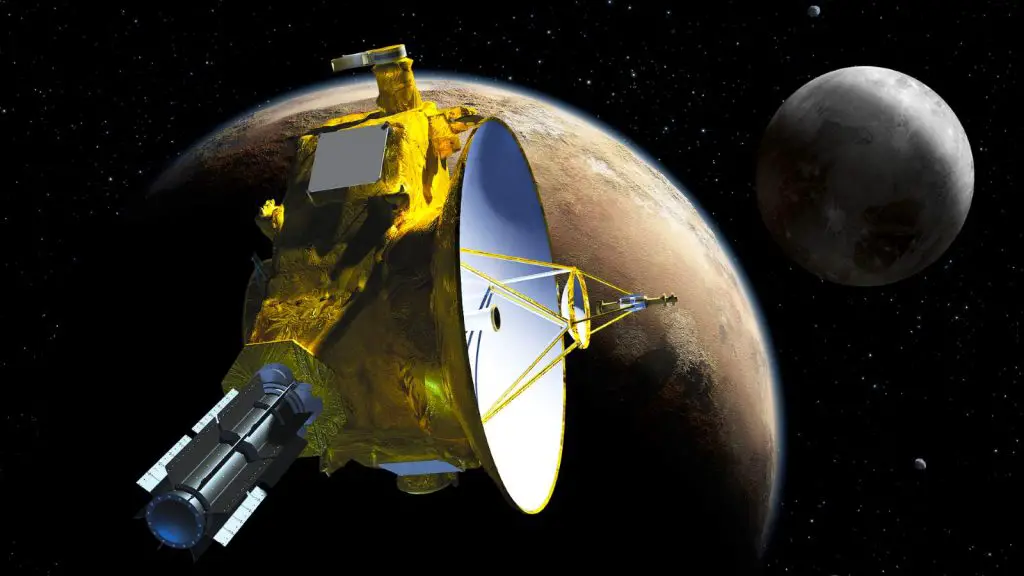Last week, NASA’s New Horizons spacecraft began sending stunning shots of Pluto on its flyover back to the Earth. Here is a beautiful Pluto flyover video created from the images from New Horizons’ closest approach to the dwarf planet on July 14, 2015.
Video: New Horizons’ amazing Pluto flyover
Using actual New Horizons data and digital elevation models of Pluto (former ninth planet – now a dwarf planet) and its largest moon Charon, mission scientists have created flyover movies that offer spectacular new perspectives of the many unusual features that were discovered and which have reshaped our views of the Pluto system – from a vantage point even closer than the spacecraft itself.
This dramatic Pluto flyover begins over the Norgay Montes (Norgay Mountains) and the highlands to the southwest of the great expanse of nitrogen ice plain informally named Sputnik Planitia. The viewer first passes over the western margin of Sputnik, where it borders the dark, cratered terrain of Cthulhu Macula, with the blocky mountain ranges located within the plains seen on the right.
The tour moves north past the rugged and fractured highlands of Voyager Terra and then turns southward over Pioneer Terra (which exhibits deep and wide pits) before concluding over the bladed terrain of Tartarus Dorsa in the far east of the encounter hemisphere.
Digital mapping and rendering were performed by Paul Schenk and John Blackwell of the Lunar and Planetary Institute in Houston.
Norgay Montes have been informally named for Tenzing Norgay (29 May 1914 – 9 May 1986), commonly known as Sherpa Tenzing, a Nepalese Sherpa mountaineer, one of the first two humans to reach the summit of Mount Everest.
Sputnik Planum is informally named for Earth’s first artificial satellite, Sputnik 1, the Soviet Union launched it into an elliptical low Earth orbit on 4 October 1957.
The images were acquired by the Long Range Reconnaissance Imager (LORRI) on July 14 from a distance of 48,000 miles (77,000 kilometers). Features as small as a half-mile (1 kilometer) across are visible.
The mountains crest 3.5 kilometers (2.2 miles) above Pluto’s surface. NASA estimates they have formed only 100 million years ago, quite young for the planetary time scale.
Our own Himalayas, for example, are generally thought to have arisen from the collision of India and Asia 55 million years ago. But according to a controversial new dating study, they may be more than 450 million years old – nine times older than previously estimated.
New Horizons’ Pluto Flyover
The Pluto flyover of New Horizons refers to the historic mission of NASA’s New Horizons spacecraft, which flew by Pluto on July 14, 2015. It was the first time that a spacecraft had visited Pluto, and the mission provided the first detailed images and measurements of the distant dwarf planet and its moons.
During the flyby, New Horizons came within about 7,800 miles (12,500 kilometers) of Pluto’s surface, allowing it to capture high-resolution images and collect data on the planet’s atmosphere, geology, and composition. The flyby also allowed New Horizons to make observations of Pluto’s five moons, including its largest moon, Charon.
The flyby was a historic moment in space exploration, as it marked the completion of the initial reconnaissance of the solar system. The New Horizons mission was launched in 2006, and it took nine and a half years for the spacecraft to reach Pluto. The mission was a remarkable achievement in engineering and technology, as it required the spacecraft to travel over three billion miles (five billion kilometers) through the outer reaches of the solar system.
Since the Pluto flyby, New Horizons has continued its journey through the Kuiper Belt, a region of icy objects beyond the orbit of Neptune. In 2019, it flew by another object in the Kuiper Belt called Arrokoth, providing new insights into the formation and evolution of the early solar system.
Pluto’s heart

New Horizons Spacecraft

New Horizons is an interplanetary space probe that was launched as a part of NASA’s New Frontiers program. Engineered by the Johns Hopkins University Applied Physics Laboratory (APL) and the Southwest Research Institute (SwRI), with a team led by S. Alan Stern, the spacecraft was launched on January 19, 2006, from Cape Canaveral Air Force Station by an Atlas V rocket directly into an Earth-and-solar escape trajectory with a speed of about 16.26 kilometers per second (58,536 km/h; 36,373 mph).
Its primary mission was to perform a flyby study of the Pluto system in 2015. It has a secondary mission to fly by and study one or more other Kuiper belt objects (KBOs) in the decade to follow. It is the fifth of five artificial objects to achieve the escape velocity that will allow them to leave the Solar System (others being Pioneer 10 – launched in 1972, Pioneer 11 – launched in 1973, Voyager 2 – launched in August 1977, and Voyager 1 – Launched in September 1977).
Sources
- New Horizons space probe on Wikipedia
- New Horizons mission page on the NASA website
- “Pluto Flyover from New Horizons” on the NASA Astronomy Picture of the Day (APOD) website
- Moon Landings: All-Time List [1966-2025] - February 2, 2025
- What Is Max-Q and Why Is It Important During Rocket Launches? - January 16, 2025
- Top 10 Tallest Rockets Ever Launched [2025 Update] - January 16, 2025


